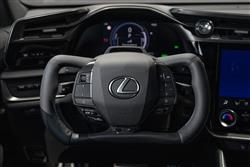UNPLUG AND PLAY (some text hidden) --NONE--
By Jonathan Crouch
With this fundamentally improved RZ, Lexus at last gets serious about EVs. Jonathan Crouch takes a look at what's on offer.
Ten Second Reviewword count: 74
The RZ wasn't the first all-electric Lexus, but it was the first one that really mattered, new from the ground up. Now though in this usefully updated form, it's properly ready to take on its upper mid-sized SUV segment premium brand EV rivals, with fresh technology, longer range, quicker charging and a wider model line-up. All embellished with the usual Lexus sheen and a new-found spirit of driver involvement. It remains an interesting confection.
Backgroundword count: 226
If you've heard of the Lexus RZ, the Japanese brand will be pleased because most people haven't. Which is surprising given this upper mid-sized luxury premium SUVs significance. It wasn't the brand's first EV - that was the slightly underwhelming UX 300e of 2020. But it was the first proper one - the first to be constructed on a dedicated Battery Electric Vehicle platform (shared with the mechanically-similar Toyota bZ4X). The RZ arrived in 2023, initially just in a single 450e form, but in 2024 a cheaper front-driven version was added to the range. A year later in 2025, major updates were made and the line-up was broadened, creating the car we're going to look at here. The look of this revised RZ isn't much different, nor is its cabin. But otherwise, Lexus hasn't left much alone here. Unlike some rivals, there is still no sophisticated 800V ultra-fast-charging architecture, but as long as the car goes further on a charge and replenishes its battery quicker (which it now does), most customers probably won't care. There's also now a much wider range of models, including a 550e F SPORT flagship version that showcases the clever steer-by-wire system we were promised at the original RZ launch (but never got with earlier versions of this model). Lots is different then. Time to take a fresh look at this car.
Driving Experienceword count: 423
Even before we get to discussion of the new steer-by-wire system that Lexus seems so proud of, an awful lot is different about the engineering of this updated RZ. Almost nothing about the BEV powertrain has been left as it was, a key change being the introduction of a new eAxle with improved motor output. This has also enhanced inverter efficiency and reduced energy losses which, together with an increase in battery size from 71.4kWh to 77kWh, has increased drive range by up to 60 miles - think around 312 miles for mainstream models. That battery now has more cells and, like the BEV powertrain, is now water-cooled. This re-engineered package can now be had in a much wider variety of flavours. As with the old model, there's an entry-level 2WD model - now badged 'RZ 350e' and offering 221bhp. But most customers will want an RZ featuring the newly revised version of the brand's 4WD DIRECT4 vehicle motion control technology, which can now more flexibly shift torque between front and rear axles to suppress pitching, sharpen cornering and produce a more direct acceleration feel. This set-up features on the core model, now badged 'RZ 500e', which puts out 376bhp (67bhp more than the 450e model it replaces). The towing capacity of this variant's been doubled too - to 1,500kg. All of which leaves only the new flagship variant Lexus really wants to talk about, the RZ 550e F SPORT. Few examples of this 402bhp derivative will be sold, but its significance is huge given that it's the first car sold in Europe with the Toyota conglomerate's 'One Grip' steer-by-wire system. With this, there's no mechanical link between the wheels and a steering wheel that is no longer a steering wheel, replaced instead by a squared yoke. That has a lock-to-lock rotation of 200-degrees, so the full turning circle can be activated with one movement (instead of two twirls with a conventional wheel). The immediacy of response is something you'd definitely have to adapt to: try before you buy. The system is optional with the RZ 500e. Unique to the 550e F SPORT is a set-up you'll take to more easily - the kind of simulated manual gearbox we first saw on the Hyundai IONIQ 5N. Here, it's operated by two finger-sized paddles behind the steering yoke and simulates an eight-speed manual gearbox, complete with 'engine noise' and a fake rev limiter. Change 'gear' and there's a brief cutting of power to simulate a gearshift and a bespoke engine note fills the cabin.
To see the full road test text contact us on 0330 0020 227
Pictures (high res disabled)
.jpg)
.jpg)
|
.jpg)
|
.jpg)
| |||
.jpg)
|
.jpg)
|

| |||
.jpg)
|

|
Statistics (subset of data only)
Min |
Max |
|
Price: |
£53,995.00 (At 2 Oct 2025, 350e Premium FWD) |
£69,995.00 (At 2 Oct 2025, 550e F Sport Takumi AWD) |
Insurance group 1-50: |
44 |
45 |
Max Speed (mph): |
99 (350e) |
112 (550e) |
0-62 mph (s): |
7.5 (350e) |
4.4 (550e) |
Electric WLTP-Rated Driving Range (miles): |
280 |
|
Length (mm): |
4805 |
|
Width (mm): |
1895 |
|
Height (mm): |
1635 |
|
Boot Capacity (l): |
522 |
|
Power (ps): |
221 (350e) |
402 (550e) |
Scoring (subset of scores)
Category: Hybrid, Plug-in, Electric & Hydrogen
| Performance | |
| Handling | |
| Comfort | |
| Space | |
| Styling, Build, Value, Equipment, Depreciation, Handling, Insurance and Total scores are available with our full data feed. | |



